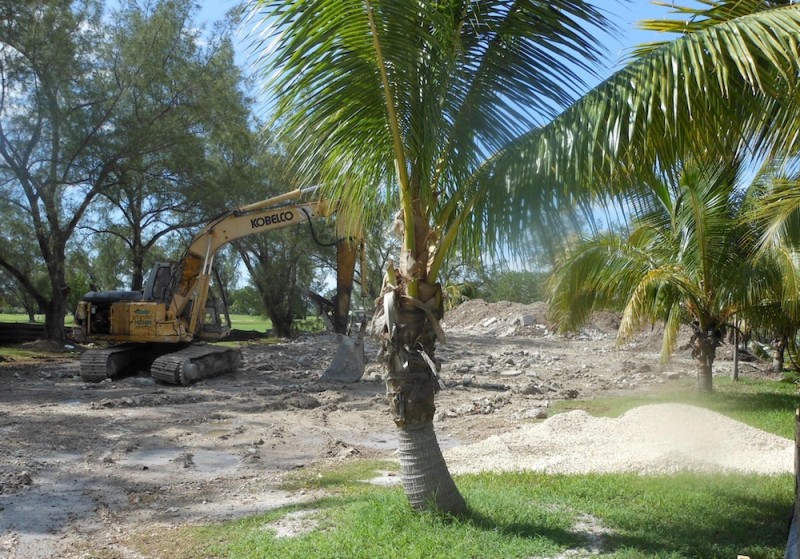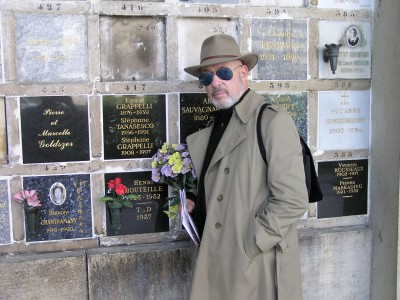Over-Development, Cronyism, and Corruption in the Middle Keys
Cities and towns love development. The more the better. More money – for rich people – more tourists, and more – low paying – jobs. That’s partly why the Marathon City Council rubberstamped a proposal to redevelop the Sombrero Country Club into what will become Florida Keys Resort.
The newly approved development may also endanger a threatened bird and the sanity of nearby residents, while calling into questions the ethics of elected government in Marathon.
The Bird
It’s well documented that Burrowing owls have lived on the Sombrero Country Club golf course for many years. The club uses the image of the owl in its logo. Bob Brock, a local realtor who lives across the street from the course and took the image above, told The Blue Paper that burrowing owls have been seen on eight different holes of the course itself.
“The owls are always there. Every year,” he said.
Popular South Florida author and The Miami Herald columnist Carl Hiaasen was so concerned about the fate of Burrowing owls that he wrote a young adult’s book called Hoot (which was made into a movie of the same name) in 2002 about a similar situation: the conflict between development and wildlife.
In the book, a trio of middle school kids try to stop construction of a pancake house on land that’s home to Burrowing owls. The construction manager claims the owls don’t exist, the city council and local chamber are enthusiastic about the national chain putting in the restaurant, and the environmental impact statement is missing from the project files. At the groundbreaking, the kids succeed in shaming the company into abandoning construction and agreeing to leave the property to the owls, rather than burying their burrows.
Such an outcome is highly unlikely in Marathon.
That’s not to say that the developer is ignorant of the presence of the owls. Barbara Mitchell of Mitchell Planning and Design in Ocklawaha, Florida, who ironically helped Crane Point Museum and Nature Center develop its conditional use permit application to install a zip line, hired a local biologist to develop an environmental assessment for the permit application for the new resort. It’s the same biologist, Phil Frank, who did the highly disputed assessment for Crane Point that claimed that a zip line would not bother White-crowned Pigeons.
Frank didn’t observe any burrows when he surveyed the site but did stress, in his report, that it’s important to monitor the project for its potential impact to the owl as construction proceeds. He cites the Florida Fish and Wildlife Conservation Commission “Florida Burrowing Owl” guidelines and states they will be followed.
The Marathon planning director’s report presented to the city council affirmed the concern but more vaguely.
“The project area is not documented habitat for any federally listed wildlife, and state listed wildlife using the property is limited to highly mobile bird species such as the White ibis. Burrowing owls are known to be present on the Sombrero golf course, therefore it is important to monitor the project and potential impacts to the Florida Burrowing Owl through all phases of the project.”
Since that report was presented in early July, the Burrowing owl has been elevated to a state threatened species.
The problem is that the permit application contains no specific plan for the monitoring. At the very least, a biologist must carefully survey the entire property, mark the current burrows, and prevent any construction at those sites. Otherwise, when construction begins and tons of fill in the form of large chunks of concrete are dumped onto the course it’s likely that the material and front loaders moving it will destroy the burrows.
Kenneth D. Meyer, PhD, executive director of the Avian Research and Conservation Institute in Gainesville, said in an email that,
“Monitoring has to be before, during, and after construction with enough time and care to establish what the owls are using now, whether that’s affected by construction, or whether the effects of the land changes result in fewer owls or successful nests.”
While Mitchell and the city have sought reviews of the plan from the Florida Department of Environmental Protection regarding vegetation on the site, they have not consulted with Florida Fish and Wildlife Commission about the owl, a step they should complete. In addition, the US Fish and Wildlife Service needs to be part of the review process. USFWS, particularly its Division of Migratory Bird Management, oversees avian species under the Migratory Bird Treaty Act (MBTA) of 1918. MBTA makes it illegal, carrying potential prosecution, for anyone to “take” – kill, pursue, hunt or capture, for example – any migratory bird or parts, nests, or eggs except under the terms of a valid permit issued pursuant to Federal regulations.
Unless the developer gets a FWC take permit specifying how many nests or feeding areas of owls they can legally take, then the legal number is 0.
Clearly local residents will have to ensure, in some way, that the new resort actually complies with these regulations, a task that may be difficult because the development is private.
In mid-summer 2014, Discount Rock and Sand began dumping fill near the fourth hole of Sombrero County Club. They did this without a permit and, after complaints, were issued a stop work notice. Eventually they paid a $ 500 fine, got an after-the-fact permit and resumed dumping.
What’s odd and troubling about this is that Discount Rock and Sand has no financial connection with the country club, at least as far as anyone knows. So who ordered and paid for the fill to be dumped across the street from a residential neighborhood?
Local gadfly realtor Bruce Schmitt pointed an accusatory finger at Peter Rosasco, the lead investor in the development project. Until recently Rosasco had been finance director of the city and though he resigned after accusations of conflict of interest, his firm Bishop, Rosasco & Co. still does work for Marathon.
Schmitt sent an email to the media and the city council saying, in part,
“But your problem is now much worse because in your rush to “fix” Rosasco’s illegal dumping operation, the City of Marathon failed to consider the environmental impacts or the need for habitat preservation. The Sombrero Country Club is known for its mascot, the burrowing owl, which lives on the golf course itself and is featured in their logo. An environmental study and a habitat analysis should have been required before any permits were issued. Why was this not required before you took your actions to help Peter Rosasco?”
Stacy Charlton, building & code department administrator for Marathon responded that,
“The Florida Department of State, Division of Corporations does not list Mr. Rosasco as a registered Agent, Officer or Director. He did not apply for nor sign for the permit. The contractor is Discount Rock & Sand. Multiple inspections have been conducted in conjunction with the Department of Environmental Protection and the removal of debris has been found to be progressing at an acceptable rate. DEP is not taking any action at this time on the reported violation. All parties have agreed work will be conducted 7AM until dusk, although our code would allow work until 10 PM.”
Charlton and the city would have us to believe that Eddie Lopez, owner of Discount Rock and Sand, took it upon himself to bring fill to the Sombrero Country Club site and essentially donate the material to the club. At that time, the property had not even been officially sold nor had the city approved resolutions to allow the development. Why would a country club in serious financial straits order fill it didn’t need?
According to Schmitt,
“Concerning the fill, I have talked directly to Eddie Lopez and he has confirmed to me that Peter Rosasco has been ordering and paying for the fill. I have questioned why the Country Club would allow their property to be turned into a fill dump site and have been told by a member of the club that they do not mind because if the sale does not take place they get to keep the free fill.”
What they’d do with it is mysterious.
While it’s true that Schmitt has been obsessed by the issue of Peter Rosasco continuing in some role as city finance director, his complaint certainly has merit.
Bob Brock, who coincidentally works for Schmitt’s firm, lives across the street from where the fill was dumped and told The Blue Paper that front loaders were out at 7 a.m. dumping huge pieces of concrete onto the course. Those front loaders are loud and emit that piercing beeping sound when they back up. It’s incredible that the city would routinely allow that kind of work from dawn to dusk in a residential neighborhood. The city code, as Charlton points out, actually allows the work to continue until 10 p.m.
Perhaps the city should think about revising its code.
City doesn’t mind who it works with
One of the reasons Peter Rosasco was compelled to resign as finance director for the city of Marathon was the perception that the city quickly granted the permit to develop the new resort because of his cozy relationship with city officials. Despite pressure from Bruce Schmitt and city councilman Mark Senmartin, the council has refused, so far, to cut its ties with Rosasco’s firm.
Senmartin and others complain that Rosasco’s fees were far out of line for services rendered to a city the size of Marathon. City manager Mike Puto was asked to compare Rosasco’s fees with those other cities were being charged. Puto was so slow in coming up with this information that he was publicly chastised by Mayor Dick Ramsay. In the meantime, Senmartin himself did the research and revealed that, indeed the outsourcing charges were much higher than that for towns of a similar size.
In response, Rosasco’s firm immediately offered to cut its charges from $ 365,000 to $ 315,000, to the amusement of many.
Rosasco was also under public scrutiny because he’d been charged with spousal abuse in February 2014 and critics wondered aloud whether he is the appropriate person for the city to do business with. The council has brushed those concerns aside.
The current vice-president of Sombrero County Club is Robert Belcaster. He’s also an investor in the new development. According to an article in the Chicago Tribune in 1996,
“A Chicago Transit Authority inquiry into a questionable stock purchase by CTA President Robert Belcaster is expected to focus partly on at least two other senior CTA officials who made similar investments, sources said Friday.
Meanwhile, CTA records showed that Belcaster’s acknowledged purchase of 7,500 shares of Ballard Power Systems stock came before the CTA board approved a $5.8 million no-bid contract with the company. A subsequent purchase of 2,500 shares came a few weeks after the board’s April 10 vote.”
According to Crain’s Chicago Business in a laudatory 2005 story about Belcaster,
He staunchly maintains he did nothing wrong when he bought 7,500 shares of Ballard Power Systems Inc. Corp. before the CTA inked $ 5.8 million contract with the Vancouver-based fuel cell maker for experimental pollution-free buses, the act that led to his resignation from the transit agency.
“The rules were not violated, best I knew,” he said. “But that doesn’t mean anything: sometimes the perception’s worse than reality.”
Once again, it must be asked if the city wants to continue to be associated with people who have questionable pasts.
Unanswered questions
There are many unanswered questions about the plan to redevelop Sombrero Country Club into Florida Keys Resort. The large number of players involved makes it difficult to track them. While Mitchell submitted the Conditional Use Application, another company – Newmark, Knight, Grubb, Frank – developed the actual plan for the resort. Reading it makes one wonder how that company could succeed as it seems to have. The proposal is full of errors, grammatical mistakes, and misinformation about the Keys.
Marathon’s headlong rush into unfettered development with new hotels and resorts is ill thought out. The planning director is not planning and the planning commission merely rubberstamps his recommendations. As a friend said recently, “There’s no vision.”
Where will the 40 workers at the new resort come from? Where will they live when the plan only calls for eight workforce housing units at the site? Will the guests and members of the resort be satisfied with the anything-but-upscale restaurants that the city has to offer, or will they simply eat at the resort restaurant, failing to increase business at local establishments?
And what will become of the threatened Burrowing owl? One hopes that local environmental activists will be watching.
~~~~~~~~~~~~~~~~~~~~~~~~~~~~~~~
Michael Welber has lived in Marathon for 16 years, and has long experience as a writer and media producer. Most recently he helped establish and was the first editor of Keys Sunday, a publication of the Keynoter. He has also been active in environmental issues in the Keys, forming and chairing the City of Marathon Green Team and creating and editing GLEE’s monthly newsletter.



Wasn’t there another another incident regarding fill and Rosasco approppriating it a few years ago ?
Unfortunately for quality of life of Marathon residents, the “development-at-any-cost” attitude pervades local government. Too many self-appointed big fish in a small (and ethically polluted) pond making decisions, the long-term implications of which either they don’t understand or don’t care. It’s money in the pocket, money under the table… today.
Wonderful reporting on an important matter. I’ve seen burrowing owls at that golf course for decades and am greatly concerned that their days are numbered. The owls are an irreplaceable treasure. The biological consultant who has been involved in so many other sordid biologically negative projects (e.g., Wisteria Island) should once again be ashamed of himself for being the shill of the developer.
Michael,
Superb article. Well thought out, written and documented.
Maybe if it gets into the hands of the ‘right people’; destruction and death will be minimized.
Thank you….
Great piece on the classic greedy developer hell bent for profit at the expense of wildlife and the environment. Send a copy of this to Carl Hiaasen ASAP and perhaps he can help sway the starry eyed City of Marathon “big fish”…